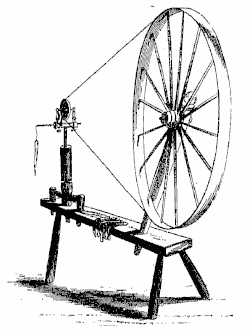Spinning wheel
|
|
A spinning wheel is a device for spinning thread or yarn from fibrous material such as wool or cotton.
The spinning wheel was an advancement on the concept of the drop-spindle, invented somewhere in China or India between 500 and 1000 AD; like the drop-spindle, the spinning wheel works by spinning the material, twisting the fibers into a long, continuous strand.
Rather than relying on finger-twisting or gravity, however, the spinning wheel is turned by hand or by a treadle (a foot pedal) (or other motivation, such as water or electric power) to turn a large wheel, which, by the use of a drive band, turns a smaller wheel. The motion of the wheel twists the thread, which is then wound on either a post called (after its predecessor) the spindle, or onto a bobbin.
Numerous types of spinning wheels exist, including the great wheel also known as "walking wheel" or wool wheel for rapid long-draw spinning of woolen-spun yarns; the flax wheel, with its bobbin and flyer assembly, for spinning linen and worsted-spun yarns; and the charka, a small, portable, hand-cranked wheel for spinning cotton and other fine, short-staple fibers.
The picture here is of a great wheel. It has several names, all of which are directly related to its appearance. It is about the height of a person, and thus is at the practical limit of the size wheel used in a home. In order to spin the fiber into yarn, one turns the wheel by hand. Each revolution of the big wheel causes many revolutions of the smaller wheel, as can be seen in the picture. The rotation of the smaller wheel then causes the spindle (the object sticking out horizontaly, often made of metal) to turn. When the person spinning the fiber wants to add more twist to the yarn they are creating, they hold the fiber away from the wheel enough so that the yarn made does not wind itself up onto the spindle. Once a sufficient amount of yarn has been made, the spinner allows the yarn to be wound onto the spindle, and starts again. One advantage of a great wheel is that controlling the tension in the yarn is much easier to adjust. Instead of messing with knobs, all that is required is a step forward or backward. Some disadvantages are that one must always be standing (a fact which gave rise to the term "walking wheel"), and that it takes more time than a standard spinning wheel because one has to stop spinning in order to wind up the yarn already made.

